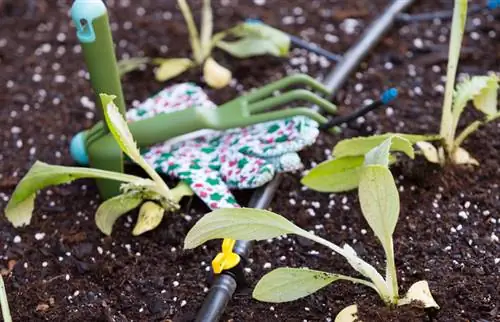- Author admin [email protected].
- Public 2023-12-16 16:46.
- Last modified 2025-01-23 11:20.
Sowing is THE absolute method of propagation for St. John's wort. While cutting propagation and division do not work for all species, sowing always works!

How can you sow St. John's wort successfully?
St. John's wort can be propagated by sowing in spring (March-April) or mid-summer. Use small pots with sowing soil, sow the tiny seeds and cover them lightly with soil. Make sure that the soil remains moderately moist and the germination temperature is between 18-22°C. The germination period is 14-24 days.
Sow in spring or midsummer
As with most other herbs, St. John's wort should be sown in spring. The period between March and April is ideal for pre-culture. Direct sowing is best done from May onwards.
If you have completely forgotten about sowing in spring, you can still sow the seeds in the bed in mid-summer (pre-cultivation at home is then no longer useful). But be careful: St. John's wort won't bloom until next year.
Putting the seeds in the ground
If the timing is right, you can get started! The seeds are tiny and are sown as follows:
- Fill bowls or pots with sowing soil or prepare the bed
- Sowing seeds
- either cover very delicately with soil or just press on (light germinator)
- moisten and keep moderately moist
- Germination temperature: 18 to 22 °C
- Germination time: 14 to 24 days
Plant the early young plants in the right location
As soon as the seeds have germinated and the plants have grown to at least 5 and a maximum of 10 cm tall, they can be planted out. A good time for this is mid-April. Feel free to enrich the soil at the location with some compost.
This is what you should pay attention to when planting:
- 30 cm distance
- Soil: deep, permeable, well ventilated, calcareous
- Do not plant in strongly acidic substrate (St. John's wort absorbs toxic cadmium)
- sunny to partially shaded location
Seeds from your own harvest or purchased
You can harvest the seeds for sowing St. John's wort yourself from existing plants. The seeds usually mature in late summer to autumn. Simply harvest the berry-like fruits and remove the seeds! However, these days you can also get the seeds from gardening stores or hardware stores.
Tip
If the soil at the location is too acidic, you can simply mix it with ground eggshells. The eggshells give the St. John's wort a lot of lime and alkalize the substrate a little.






